16 Jan 2025
Bri Barnett
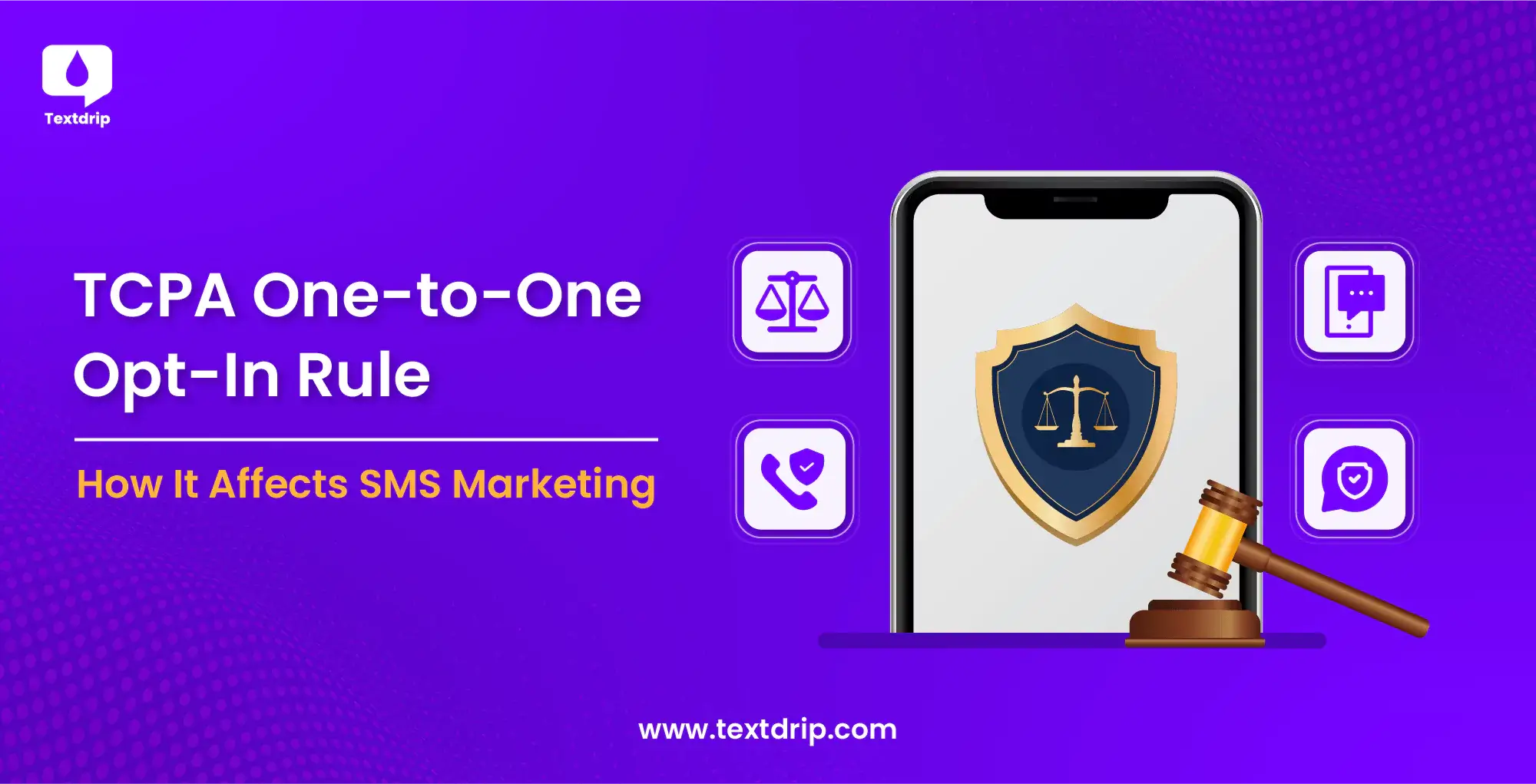
16 Jan 2025
Bri Barnett
Consent and trust are the foundation of any successful interaction, and business is no exception. Businesses must obtain consumer consent if they want to collect, share, or use their personal information in any way. Consumers must give this consent freely, and it should be specific, clear-cut, and informed.
Confused? Umm.. let’s explain to you in simple terms.
Consent must not be obtained via compulsion, complicated processes, or dark patterns. Businesses that want to connect with their target audience through SMS marketing and telecommunication must comply with TCPA to protect consumer privacy and shield them from unsolicited telemarketing texts and calls.
However, these TCPA rules are constantly evolving to keep up with the changing online consumer habits and online marketing. Days of blanket opt-in consent rules are about to get over—all thanks to a TCPA one-to-one Opt-In consent rule coming on January 27, 2025.
According to this TCPA one-to-one Opt-In rule, businesses/marketers promoting their services or products through autodialing or automated texts must obtain explicit prior written consent from consumers separately for each individual seller/company.
In this blog, we’ll discuss the TCPA one-to-one opt-in rule, how it impacts SMS marketing, and what happens if you don’t comply in detail.
Let’s dive in!
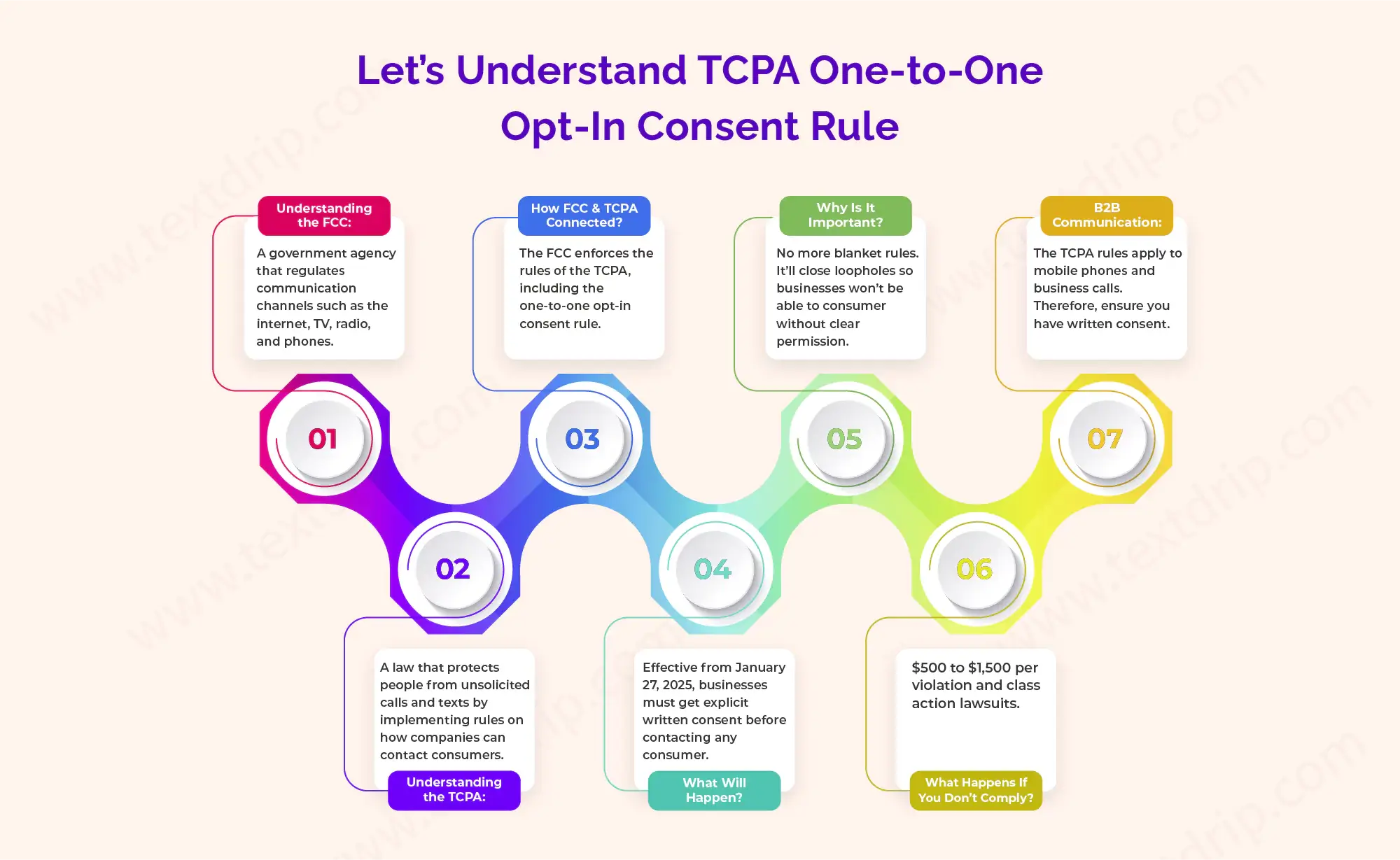
It is the major update to the TCPA. As per this rule, businesses must obtain specific express written consent from consumers for each seller/organization they represent.
This consent must be clearly revealed and separately signed. The below image shows how express written consent looks like:
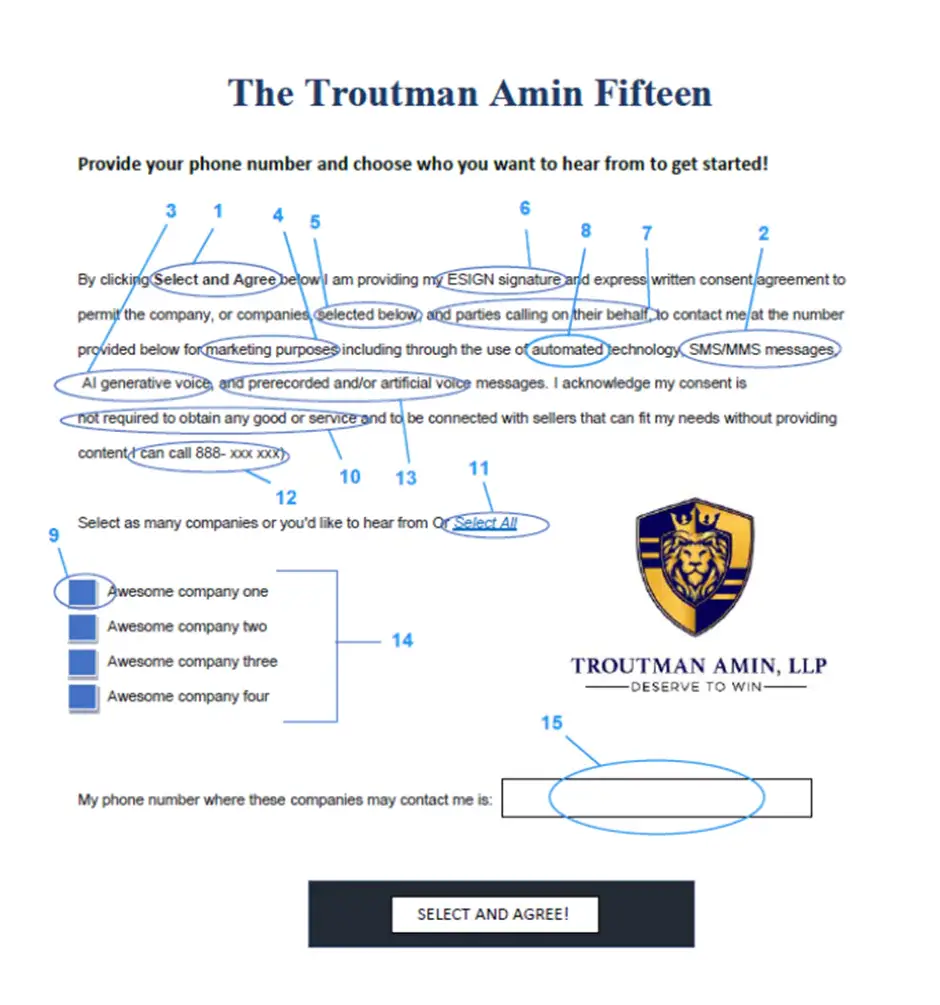
Image Source: Link
Gone are the days when companies usually relied on a single consent to cover telemarketing calls and texts from multiple sellers.
The rule also requires that the robocalls and robotexts that consumers get after they give consent must be logically and topically aligned with the website ( in the context of a comparison-shopping website). This new rule ensures that consumers don’t receive automated texts and automated calls beyond their consent’s scope.
The aim of this rule is to close the lead generation loophole or blanket consent. It means a single long disclaimer that includes multiple business names asking for blanket consent all at once.
For example, the FCC – Federal Communication Commission no longer allows the following type of consent.
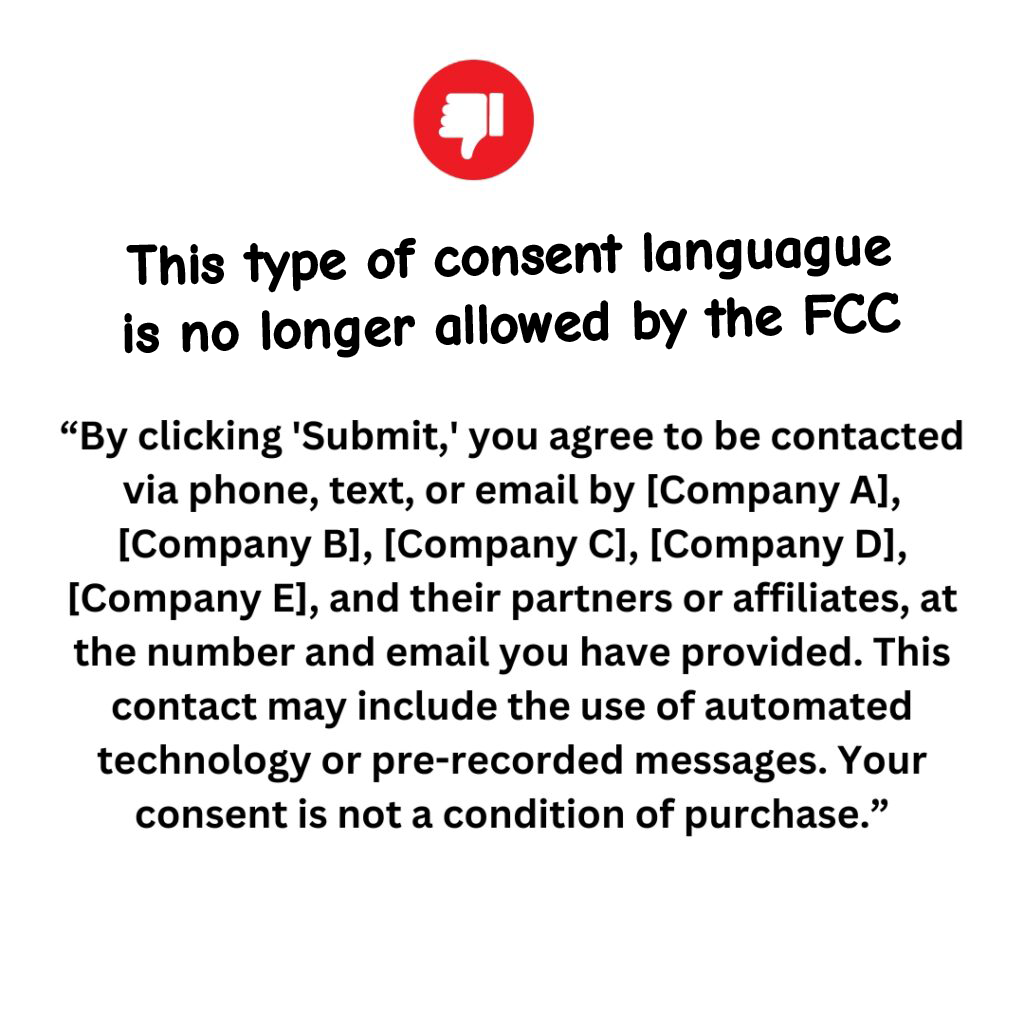
The new rule ensures that consumers understand entirely, are aware of, and are informed and authorized which businesses/sellers can contact them. Consumers must check a box that displays the company/business names trying to contact them to give consent. This One-to-One Opt-in rule improves transparency and protects consumers from unwanted messages, as it requires consent from each seller.
With the effect of this new rule, consumers have control over who can contact them. It ensures that no third parties can prevent misuse of consumer data. Besides, the rule eliminates the uncertainty in the consent.
The One-to-One Opt-in rule will be effective from January 27, 2025. If businesses fail to comply by this date, they will have to face consequences such as financial penalties ranging from $500 to $1,500 per unwanted text or call. In severe cases, businesses can face class-action lawsuits that lead to multi-million-dollar penalties. Besides that, it can affect the business’s reputation by disrupting the SMS campaign and causing a loss of consumer trust.
In short, the new One-to-One Opt-In consent rule is not optional. Businesses must prioritize them to keep skyrocketing their ROI.
The new One-to-One Opt-In rule transforms how businesses collect and use consumer data for SMS marketing. Businesses relying solely on aggregated data from third parties or shared lead databases face challenges.
Why?
It is because blanket consent will no longer work!
Let’s understand it through a simple example.
Restaurants or service-based businesses that use SMS campaigns to target mobile users previously used blanket consent. However, now they need to ensure that each consumer provides specific consent for their company/organization.
Now, third-party lead sources will also need to revise their practices. They will have to include individual opt-ins for every seller listed.
This new rule will transform how businesses approach SMS marketing through a few key changes.
Businesses need to change their lead-generation tactics. It means that companies will no longer rely on third-party leads. Instead, they must collect explicit, specific written consent directly from consumers. They need to employ technological integration changes. Cutting-edge tools like AI (Artificial Intelligence) and ATDS (Automated Dialing Systems) must meet compliance requirements to avoid potential violations.
All these SMS compliance changes are not so easy to implement. Businesses might face many challenges. Let’s discuss these challenges and their solutions.
It’s not easy for businesses to obtain separate consent for each seller. Also, managing consent records is complex.
You may be wondering how to resolve these issues.
It’s simple.
Businesses need to simplify the consent process through clear and user-friendly forms.
For example, businesses can use the below template to get consent for multiple companies.
“By clicking “Submit”, I agree to be contacted at the number provided by the (selected companies) for marketing purposes. This may include texts or calls via automated systems, AI-generated voice, SMS/MMS, and prerecorded messages. I acknowledge that my consent is not needed to purchase any goods or services. For help or opt-out, call {phone number}.”
(Include a check box before each company name so consumers can select which company to contact them.
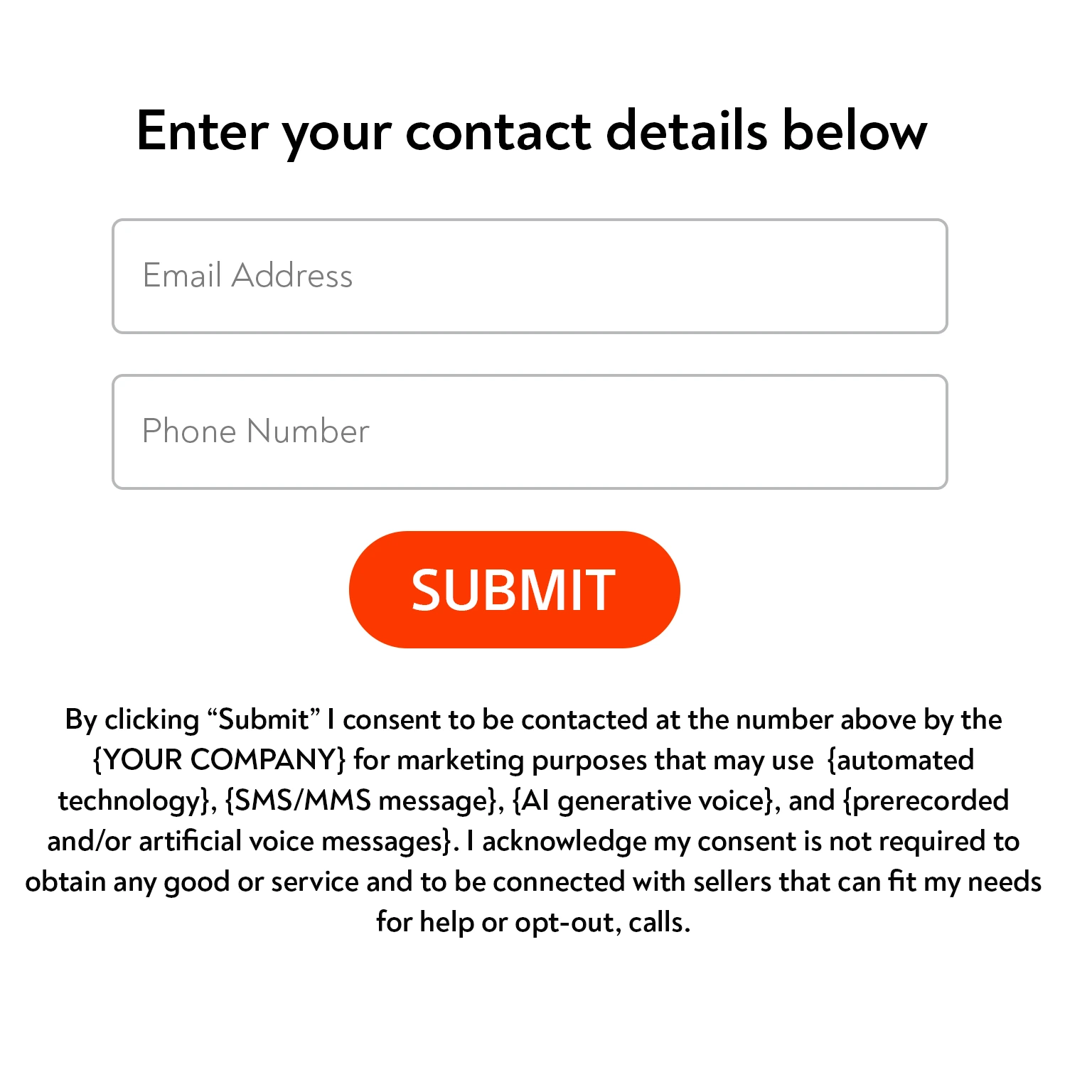 (Image Source: Link)
(Image Source: Link)
Here is the simple consent template businesses can use for a single company.
By clicking “Submit”, I agree to be contacted at the number provided by (your company name) for marketing purposes. This may include texts or calls via automated systems, AI-generated voice, SMS/MMS, and prerecorded messages. I acknowledge that my consent is not needed to purchase any goods or services. For help or opt-out, call {phone number}.
Reply YES to agree to receive texts or calls from [Your Company Name] for marketing, including automated, AI, SMS/MMS, & prerecorded messages. Consent isn’t required to buy. For help/opt-out, call [Phone Number].
Businesses can even use automated SMS marketing platforms like Textdrip to automate consent collection and management.
As we’ve discussed in the above section, businesses must use easy-to-understand consent forms. The form and its content should clearly explain to consumers which methods the specific seller or companies seeking consent will use to communicate with them. And for which purpose they will contact consumers.
In short, businesses should use simple language to explain why consent is needed and how it will be used.
For example, when businesses use content like this –
By submitting your phone number, you agree to receive SMS/MMS updates from [company name]. You may opt out any time.
It clearly explains to consumers who will contact them. It also informs consumers that they can opt-out at any time if they find that the content they’re receiving is beyond the scope of their consent. Besides, ensure the form is user-friendly and only has relevant fields.
The best practices that businesses should use to obtain text message consent through clear opt-in methods such as:
Companies/businesses should explicitly mention their name in the consent disclosure. Don’t use generic statements such as “third parties may contact you” are not sufficient.
Use clear and straightforward language. Don’t use complex terms or legal jargon that can confuse customers otherwise they misinterpret or misunderstand the consent.
In case you’re obtaining consent for multiple purposes, ensure you mention each purpose separately and get separate consent for each purpose.
Businesses should remember that they also need to get and store consent as it serves as proof. Record every lead’s consent including time, date, and the specific disclosure they agreed to. It is important for TCPA compliance. In case any legal challenge or TCPA-related queries arise, you’ve proof to show. For that, businesses should store consent forms securely. They can use the timestamped records to verify when and how the particular consent was obtained. Another practice that businesses must employ is to regularly audit consent records to make sure that the records are accurate and up-to-date.
Automated SMS marketing platforms such as Textdrip have impressive features that simplify compliance. The platform can automate consent collection (opt-in process) and also lets you manage opt-out easily.
How?
It offers you a tool named positiveintent.ai. The tool combines automation, AI-based intent detection, and classification to manage opt-out requests accurately.
When the customer responds like this: “I don’t want to hear from you” or “Please stop sending me offers”, the tool identifies the customer’s intent to opt out and take immediate action even if the response message does not contain any specific opt-out keywords like ‘STOP’ or ‘UNSUBSCRIBE’.
The tool analyzes the inbound messages and classifies them into one of three intents.
Textdrip helps manage opt-in and opt-out through automation, supporting businesses in complying with this new One-to-One Opt-In consent rule.
If, as a business owner, you want to integrate compliance into your marketing strategy, educate your team. Ensure your employees understand the importance of TCPA compliance and the new One-to-One Opt-In rule.
You can use the automated SMS marketing platform like Textdrip to simplify consent management and minimize manual errors. Besides, regularly review SMS campaigns so that you can be sure that the campaigns are aligned with the compliance standards.
If businesses fail to comply with the One-to-One Opt-In consent rule, they’ll have to face penalties for TCPA violations. They may face fines from $500 to $1,500 per violation. If your business is operating on a large scale, this can quickly add up.
The TCPA violations can lead to class actions, which can increase the damage cost by nearly millions of dollars. In some cases, courts can even issue injunctions to stop further violations. You need to change your business practices for it or even halt certain communications entirely.
Besides legal and financial damages, non-compliance can lead to decreased customer engagement as they receive unwanted messages. It can completely disrupt your SMS campaign, its goal, and marketing efforts.
January 27, 2025, is just around the corner! If you’re still thinking about whether or not the TCPA One-to-One Opt-In consent rule impacts your business, the simple answer to this is:
Just
Get
Consent
No matter whether you’re using SMS/MMS, robotexts, AI-generated voice, prerecorded calls, or robocalls to contact consumers, getting consent is the right thing to do.
It will protect your business and your clients, too! The cherry on top is that it will keep the FCC satisfied.
Besides, promoting your product or service to consumers who’ve explicitly given consent will improve your sales process, too.
Emphasize compliance and transparency, and use automated SMS marketing platforms like Textdrip to avoid TCPA violations.
As January 27, 2025, is approaching, Just Get Consent and build stronger, trustworthy relationships with your customers. It will help you make your marketing campaign effective, consumer-focused, and TCPA-compliant.
So, what are you waiting for?
It’s time to act NOW!
The TCPA (Telephone Consumer Protection Act) One-to-One Opt-In Rule requires businesses to obtain prior express written consent from individuals before sending them SMS marketing messages that ensure consumers have explicitly agreed to receive promotional texts.
Prior express written consent’ means that the individual has signed an agreement, either electronically or physically, allowing the business to send SMS marketing messages to their mobile number. This agreement must clearly outline the type of messages they will receive and acknowledge that consent is not a condition of purchase.
Yes, exceptions include transactional or relationship messages, such as order confirmations or appointment reminders, which do not require prior express written consent. However, promotional content mixed with these messages would require consent.
Businesses that violate the TCPA can face hefty fines, with penalties ranging from $500 to $1,500 per unsolicited message, depending on whether the violation was unintentional or willful.